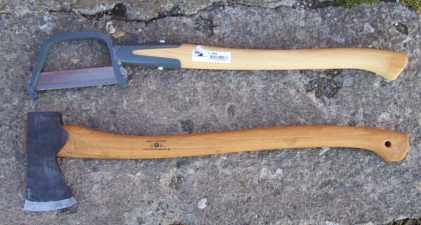
A picture of the brush axe (top) alongside the Gransfors Bruks forest axe :

Out of the few dozen pieces at the hardware store, the blade protectors (a folded over piece of plastic) were missing from many which resulted in notches in the edges from accidental contacts up to a millimeter deep. The handles varied quite a bit in regards to grain orientation many were heavily knotted, even along the edge of the handle. There were a few clean ones with vertical grain the best was chosen which also had a small nick in the blade, ~ 1/4 millimeter deep.
The axe weighs 930g, a little lighter than the Bruks forest axe. The blade is 6" wide and the face is 3.5" deep. The edge is flat ground to 12 degrees per side. The edge showed no flaws under magnification besides the one small notch however was very dull and could not even catch on the thumb nail. It took busted the light thread used to measure sharpness and under and a 1000 g load, with a full 6" slice, it could only score 1/4" poly. Basically no actual cutting ability.
On light brush, the very low initial sharpness prevented clean cutting and the brush axes tended to just knock the wood around. On heavier wood, limbing a couple of small trees, it was readily out cut by the forest axe. The Brush Axe did not start the cut smoothly and thus you could feel the initial impact more readily than with the GB axe. A quick check on the limbs revealed that there was too much denting, the edge was too blunt to start a clean cut. A few minutes with a couple of small hones and finishing with some stropping on 0.5 micron chromium/aluminum oxide loaded leather left the blade shaving sharp.
The Brush Axe was used to first take down a few small trees about 2 inches in diameter. It got high penetration and could handle this class of wood in one to two hits at maximum. These were decently hard woods, not fresh, as they were mainly dead. On fresh wood it would have been in one hit easily. The small sparse branches on these trees were easily swept off. The forest axe from Gransfors Bruks had no real advantage on this class of work, and in general because it was heavier caused a higher rate of fatigue. However when the Brush Axe was used on larger wood, it would bind heavily and have to be twisted back and forth to work the blade out. In comparison the Forest axe doesn't get stuck and thus you don't waste the time and effort to free the bit. Also, when limbing, the branches often came through the head which increased fatigue as it dragged on the axe.
In addition, because the Brush Axe doesn't have points it can't make clean sweeps through thick brush. The ends of the frame are blunt and smack into the branches which transmits huge impact shocks, as well as of course it lowers the cutting ability by slowing down the blade. The Forest axe has no problems with such work, and you just keep sweeping in from the outside, clearing your way as you go. Also, the blade on the brush axe is held in place on top just by a small detent. After some heavy chopping the blade was knocked out of this notch. The blade doesn't come out of the head however was drove into the back of the frame and started cutting into the much softer metal of the frame. The blade can be knocked back into place just by hitting it off of a piece of wood.
After using the blade for awhile the edge started to ripple. The dents were that severe that about a half an inch of the edge was lost. A small hammer was used to get the edge back into shape, and filed the worst of the damage out.
The Brush Axe, after a proper sharpening, will outcut a Bruks forest axe on light brush, but fall behind readily on heavier work. It is easily exceeded by a decent long blade for brush cutting, but the brush axe can be argued to be safer for a novice and does have replaceable blades.
Comments can be sent to : cliffstamp[REMOVE]@cutleryscience.com or by posting in the following thread :
| Last updated : | 01 : 10 : 2006 |
| Originally written: | 02 : 25 : 2002 |